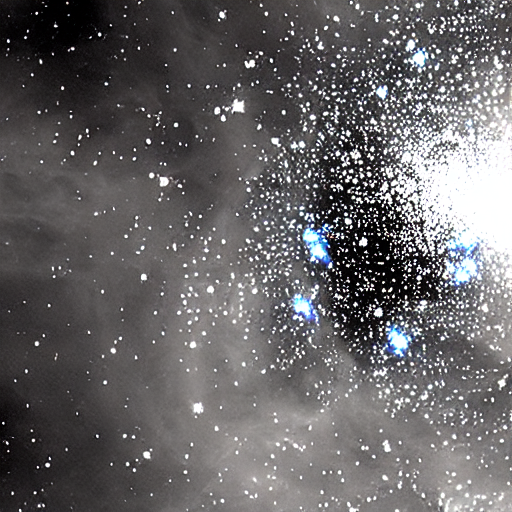license: creativeml-openrail-m
language:
- en
tags:
- stable-diffusion
- stable-diffusion-diffusers
- text-to-image
widget:
- text: >-
Hubble snaps images of the birthplace of stars within a cluster: The dust
and gas expand within the cluster due to the powerful influence of baby
stars. With these new images comes improved detail and a clearer view for
astronomers to study how early stars are born and change over time.
example_title: Baby Stars
- text: >-
Hubble captures the death of a star: Old stars, nearing the end of their
life, collapse under the weight of their own gravity and the outer layers
explode as a 'supernova'. In this image Hubble captures the moments after
collapse, where the star has exploded and left an empty void in its place,
where a new black hole has emerged.
example_title: Old Stars
- text: >-
Hubble image of galaxies colliding: The distorted spirals of two distant
galaxies colliding are captured here in a new image from the NASA/ESA
Hubble Space Telescope. The typically symmetric spirals common in spiral
galaxies appear significantly warped, as the shape of both galaxies is
torn apart by their gravitational pulls.
example_title: Galaxies Collide
- text: >-
Pink-tinted plumes in the Large Magellanic Cloud: The aggressively pink
plumes seen in this image are extremely uncommon, with purple-tinted
currents and nebulous strands reaching out into the surrounding space.
example_title: Pink Plumes
- text: >-
The stellar plasma of Wolf 359: The red dwarf star Wolf 359 from the
constellation Leo is captured in extreme detail in a new image from the
NASA/ESA Hubble Space Telescope. Wolf 359, classified as a M6 red dwarf,
has certain peculiar qualities indicated by an unusual ejection of plasma.
The Hubble telescope was able to capture one such event
example_title: Wolf 359
extra_gated_prompt: >-
This model is open access and available to all, with a CreativeML OpenRAIL-M
license further specifying rights and usage.
The CreativeML OpenRAIL License specifies:
1. You can't use the model to deliberately produce nor share illegal or
harmful outputs or content
2. The authors claim no rights on the outputs you generate, you are free to
use them and are accountable for their use which must not go against the
provisions set in the license
3. You may re-distribute the weights and use the model commercially and/or as
a service. If you do, please be aware you have to include the same use
restrictions as the ones in the license and share a copy of the CreativeML
OpenRAIL-M to all your users (please read the license entirely and carefully)
Please read the full license carefully here:
https://huggingface.co/spaces/CompVis/stable-diffusion-license
extra_gated_heading: Please read the LICENSE to access this model
thumbnail: ''
inference: true
datasets:
- Supermaxman/esa-hubble
Hubble Diffusion v1: Stable Diffusion v1.4 fine tuned on ESA Hubble Deep Space Images & Captions
Put in a detailed text prompt and generate Hubble Deep Space Images!
Hubble captures the death of a star: Old stars, nearing the end of their life, collapse under the weight of their own gravity and the outer layers explode as a 'supernova'. In this image Hubble captures the moments after collapse, where the star has exploded and left an empty void in its place, where a new black hole has emerged.
Hubble snaps images of the birthplace of stars within a cluster: The dust and gas expand within the cluster due to the powerful influence of baby stars. With these new images comes improved detail and a clearer view for astronomers to study how early stars are born and change over time.
Hubble image of galaxies colliding: The distorted spirals of two distant galaxies colliding are captured here in a new image from the NASA/ESA Hubble Space Telescope. The typically symmetric spirals common in spiral galaxies appear significantly warped, as the shape of both galaxies is torn apart by their gravitational pulls.
Model Details
- Developed by: Maxwell Weinzierl
- Model type: Diffusion-based text-to-image generation model
- Language(s): English
- License: The CreativeML OpenRAIL M license is an Open RAIL M license, adapted from the work that BigScience and the RAIL Initiative are jointly carrying in the area of responsible AI licensing. See also the article about the BLOOM Open RAIL license on which our license is based.
- Model Description: This is a model that can be used to generate and modify images based on text prompts. It is a Latent Diffusion Model that uses a fixed, pretrained text encoder (CLIP ViT-L/14) as suggested in the Imagen paper, with initial weights from CompVis/stable-diffusion-v1-4. It was fine-tuned on Supermaxman/esa-hubble.
- Resources for more information: GitHub Repository, Paper.
- Cite as:
@misc{weinzierl2023sdhubble1,
author = {Weinzierl, Maxwell A.},
title = {Hubble Diffusion v1: Stable Diffusion v1.4 fine tuned on ESA Hubble Deep Space Images & Captions},
year={2023},
howpublished= {\url{https://huggingface.co/Supermaxman/hubble-diffusion-1}}
}
Also, be sure to check out the new and improved Hubble Diffusion v2!
Examples
We recommend using 🤗's Diffusers library to run Hubble Diffusion.
Usage
pip install transformers diffusers accelerate
import torch
from diffusers import StableDiffusionPipeline
model_id = "Supermaxman/hubble-diffusion-1"
pipe = StableDiffusionPipeline.from_pretrained(model_id, torch_dtype=torch.float16)
pipe = pipe.to("cuda")
# saves significant GPU memory for small inference cost
pipe.enable_attention_slicing()
prompt = "Hubble snaps images of the birthplace of stars within a cluster: The dust and gas expand within the cluster due to the powerful influence of baby stars. With these new images comes improved detail and a clearer view for astronomers to study how early stars are born and change over time."
image = pipe(prompt).images[0]
image
Model description
Trained on ESA Hubble Deep Space Images & Captions using Google Colab Pro with a single A100 GPU for around 33,000 steps (about 12 hours, at a cost of about $20).
Links
- Captioned Hubble Deep Space Scans dataset
- Model weights in Diffusers format
- Training code
- Hubble Diffusion v2
Trained by Maxwell Weinzierl (@Supermaxman1).
Citation
@misc{weinzierl2023sdhubble1,
author = {Weinzierl, Maxwell A.},
title = {Hubble Diffusion v1: Stable Diffusion v1.4 fine tuned on ESA Hubble Deep Space Images & Captions},
year={2023},
howpublished= {\url{https://huggingface.co/Supermaxman/hubble-diffusion-1}}
}



